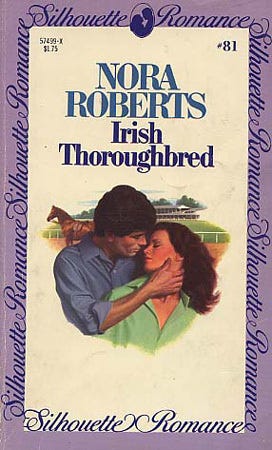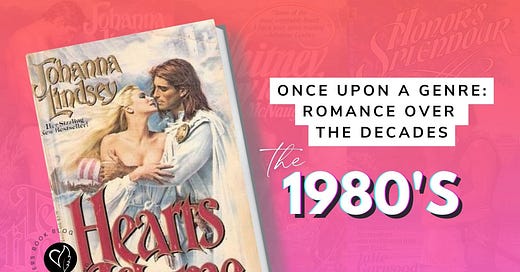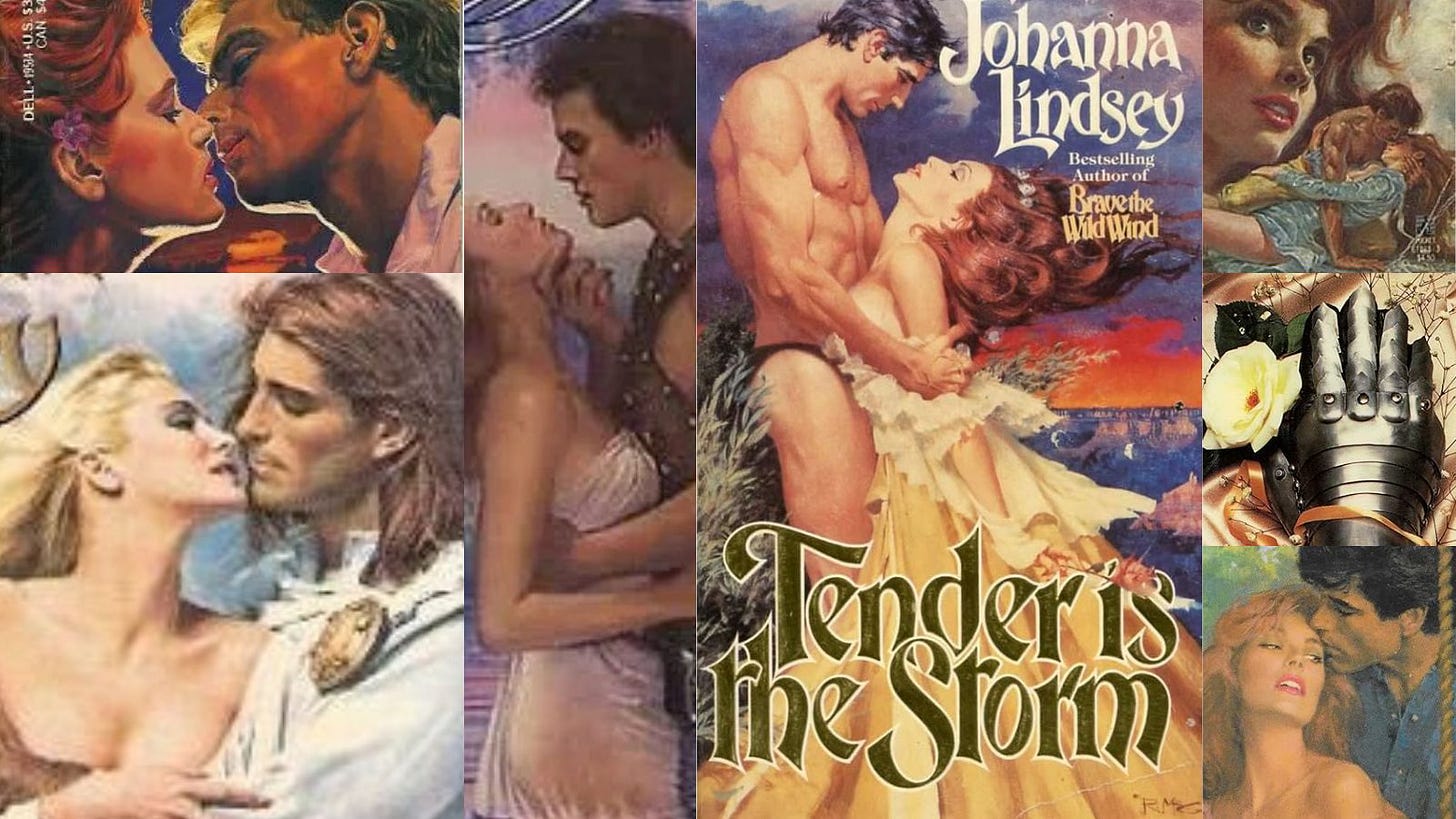1980s: The Golden Age of Romance
What if you could trace the evolution of the romance genre, one era at a time?
You’d meet heroines in corsets and secretaries on lunch break, Greek billionaires with brooding eyes, and a publishing industry in full-blown transformation. The genre has never stood still—and neither have its readers.
Last week we looked at the 1970s, when romance got messy, sexy, and mass-market. This week, we’re stepping into the decade when romance went mainstream, professional, and gloriously over-the-top.
Missed the 70s? Catch up here:
This post contains affiliate links. That means we receive a small commission at no cost to you from any purchases you make through these links.
What Were Readers Reading?
Romance readers in the ’80s weren’t just consuming—they were devouring. Whether tucking Silhouettes into a purse or stacking Lindsey hardcovers on the nightstand, readers found stories for every mood: lush historicals full of drama, sharp contemporary tales with heat and humor, and category romances that delivered satisfaction in one sitting.
Romance wasn’t just a hobby. It was an identity.
And it was expanding. Sci-fi and time travel began creeping into storylines. Heroines worked real jobs. Heroes had trauma under the bravado. Even within a 192-page category title, readers could find emotional arcs that hit hard.
Who Was Writing Romance?
The 1980s marked a turning point—not just for the stories on the page, but for the people writing them.
Readers began to recognize romance authors by name. These weren’t anonymous scribes behind pastel covers; they were voices, brands, and careers in the making. Writers were no longer churning out stories as side gigs or hidden passions. They were building readerships, signing multi-book contracts, and treating romance as a profession—with deadlines, royalties, and fanbases to prove it.
The rise of the career romance author meant readers began to follow names like Judith McNaught, Johanna Lindsey, Jude Deveraux, LaVyrle Spencer, and Nora Roberts—not just for their plots, but for their emotional style. Each brought a signature flavor to their work: sweeping angst, wild historical adventure, grounded contemporary warmth. These voices shaped not just what romance was in the ’80s, but what it could become.


And few stories better capture that moment than Nora Roberts. When Silhouette Books launched in 1980 to spotlight the American voices Harlequin had passed over, Roberts submitted her first manuscript. It became Irish Thoroughbred (1981), published under the pen name "Nora Roberts"—a shortened version of her real name. She thought she needed a pseudonym, because didn’t all romance authors have one?
Between 1982 and 1984, she wrote 23 novels for Silhouette, publishing across imprints like Special Edition, Desire, and Intrigue. By 1985, Playing the Odds—the first in her MacGregor family saga—hit bestseller lists and cemented her as a rising force.
Authors like Jayne Ann Krentz were already carving out space for the genre’s future, writing contemporary romance while planting the seeds for the historicals (as Amanda Quick) and paranormals (as Jayne Castle) that would follow. She captured the heart of what romance really offered readers—not just fantasy, but agency.
“The romance genre is the only genre where readers are guaranteed novels that place the heroine at the heart of the story,” Krentz said. “These are books that celebrate women's heroic virtues and values: courage, honor, determination and a belief in the healing power of love.”
Not all authors published under their real names. Some worked under house pseudonyms, while others used pen names to cross genre boundaries—or to obscure gender altogether. Behind names like Jessica Stirling or Laura London were men—writing alone or in collaboration—whose voices helped shape the genre while blending into its expectations.
Regardless of who held the pen, the message was clear: this wasn’t just a creative outlet. Writing romance had become a legitimate career path—and for many, a personal mission to put women’s stories at the center of it all.
Who Was Publishing Romance?
In the ’70s, romance proved it could sell. In the ’80s, publishers built an empire around it.
The biggest shakeup came in 1980, when Silhouette Books launched to spotlight American voices—and heat levels—that Harlequin had previously passed on. Their gamble worked. By 1984, Harlequin acquired Silhouette, absorbing its popular lines and ramping up output.
New category imprints rolled out like clockwork:
Harlequin American Romance (1983) brought small-town warmth
Harlequin Temptation (1984) upped the sass and steam
Silhouette Desire, Special Edition, and Intimate Moments gave readers niche-specific emotional beats
Meanwhile, Dell’s Candlelight Ecstasy line pushed boundaries—publishing the first Black romance hero in a mainstream title and elevating emotional intensity across the board.
And it wasn’t just bookstores. Romance flooded grocery aisles, pharmacies, and mail-order subscriptions. Wherever readers were, publishers were there.
Romance Hits the Headlines
With market domination came cultural scrutiny. Romance became a frequent target in media think pieces, academic essays, and casual criticism. Was it empowering? Was it regressive? Was it all just fantasy?
Feminist scholars were split. Some saw agency and emotional catharsis. Others saw gendered tropes that reinforced patriarchy. Critics called the books fluff, even as they propped up publishing houses. And through it all, readers kept reading—unbothered, loyal, and emotionally invested.
RWA & The Legacy of Vivian Stephens
In 1980, Vivian Stephens, a groundbreaking Black editor at Dell, wasn’t just shaping romance—she was redefining it.
She launched the Candlelight Ecstasy line, bringing more emotional complexity, higher heat, and underrepresented voices into mainstream category romance. But she didn’t stop at editing. That same year, she helped establish the Romance Writers of America (RWA) to support the professional growth of romance authors—offering craft education, industry access, and a path to legitimacy in a genre long dismissed by literary gatekeepers.
Stephens didn’t just make space for more diverse characters. She made space for diverse authors. She helped publish Entwined Destinies by Elsie B. Washington, the first known category romance by a Black author featuring Black protagonists. She mentored and supported writers like Sandra Kitt, Brenda Jackson, and Beverly Jenkins—paving the way for a future that reflected more of the readers who were already deeply engaged with the genre.
Her contributions weren’t fully recognized for decades. The RITA Awards, established in 1982, began celebrating excellence in the genre (even if they would eventually face their own reckoning with bias). But in 2021, the RWA formally renamed their top honor The Vivian—a long-overdue acknowledgment of the foundation she laid.
Stephens believed that love stories were for everyone—and she fought to make sure those stories had a place in publishing. Her legacy isn’t just editorial. It’s structural. It’s cultural. And it continues to shape the genre today.
Characters, Tropes & Emotional Blueprints
The 1980s didn’t just amplify romance tropes—it gave them emotional weight and cinematic scale. Readers started gravitating toward patterns: setups that guaranteed tension, heartbreak, and ultimately, catharsis.
The alpha hero vs. spirited heroine dynamic dominated shelves—fueled by misunderstandings, sharp tongues, and high emotional drama. Books like Whitney, My Love delivered a fantasy that was intense, controversial, and addictive. These were not soft romances—they were battles of will with hard-earned HEAs.
Captive romances, like The Windflower, explored trust and power in dangerous settings. And quieter stories, like Morning Glory, leaned into emotional healing, showing that love could be slow, steady, and safe—and still swoon-worthy.
Meanwhile, category romance served bite-sized emotional hits set in Greek villas, Caribbean estates, and desert palaces. The heroes were sheikhs, billionaires, or secret princes; the heroines were grounded, relatable women drawn into whirlwind relationships. Secret babies, revenge plots, and forced proximity gave these shorter stories big emotional arcs—and readers kept coming back for more.
The Rise (and Complications) of the Alpha Hero
The ’80s belonged to the alpha: brooding, possessive, emotionally repressed—and hot enough to melt the page.
These men were landowners, pirates, dukes, CEOs. They commanded rooms. They kissed like it was war. And they were often, frankly, terrible communicators. But that was the appeal. Watching them fall—slowly, unwillingly, and then all at once—was the payoff readers craved.
But fantasy gets messy.
Many of these stories blurred the lines around consent, emotional safety, and coercion. Books like Stormfire pushed the envelope—and then tore it up. These heroes didn’t ask. They took. And while the genre framed it as passion, readers today often see something more troubling.
Even at the time, readers were split. Some loved the emotional stakes. Others hated the dynamics. But no one was indifferent.
🎥 Want more on the rise of the alpha hero and the era of the power couple?
I unpack the fantasy, the fallout, and why these stories still haunt us (in the best and worst ways) in this episode of Reading Under the Covers:
Covers: The Clinch Gets Cinematic
If the ’70s flirted with the clinch, the ’80s embraced it with windblown hair, shredded bodices, and absolutely zero subtlety.
This was the era when the romance cover became art, marketing, and cultural shorthand—all at once. These weren’t just book jackets. They were emotional invitations. One look at a 1980s clinch and you knew exactly what kind of storm was waiting inside.
Illustrators like Melissa Duillo Gallo, Max Ginsburg, and Robert Maguire gave us lavish, painterly covers that weren’t afraid of muscle, fabric, or a suggestive tilt of the neck. These images weren’t just decoration. They were the fantasy itself.
And then, of course, there was Fabio. His 1987 debut on Hearts Aflame marked the beginning of a visual dynasty. He wasn’t just a model—he was a brand. And for many readers, he became the physical embodiment of the alpha hero they were already obsessed with.
By the late ’80s, we saw the rise of the stepback cover—that genius double-layer format with a modest outer shell (a manor, a title, a moonlit tree) and a full-color clinch hidden inside. It was a playful compromise between discretion and desire. You could keep your secrets and your steam.
These covers didn’t just reflect the stories—they shaped the reader’s expectations. They became collectible, iconic, even aspirational. Whether readers loved them, mocked them, or secretly treasured them, the clinch cover became an essential part of the romance reading experience.
📌 We’ll be doing a full post later in this series on the history and evolution of clinch covers—because this much fabric, tension, and chest deserves its own spotlight.
The Teen Romance Boom
While adult romance was heating up shelves, the 1980s also sparked a golden age of teen romance—stories that felt softer, sweeter, but no less emotionally intense.
Lines like Sunfire, Wildfire, and Caprice gave young readers their first taste of love stories—full of awkward glances, misunderstood notes, and first kisses that felt like forever. These were the books that lived in backpacks, were traded between friends, and read under covers with flashlights.
In the Sunfire line, each title centered a historical backdrop with a love triangle twist. Books like Caroline (Revolutionary War), Elizabeth (Oregon Trail) by Willo Davis Roberts, and Danielle (Roaring Twenties) by Schurfranz gave teen readers a blend of romance and girlhood agency.
Meanwhile, Wildfire titles like P.S. I Love You by Barbara Conklin (1981) and Caprice entries like Jenny by Natalie Johnson (1982) and Dance with a Stranger by Elizabeth Van Steenwyck (1982) centered around modern teens navigating crushes, friendships, and messy social drama—with maximum angst.
These books leaned sweet—but the longing? That was real. And for many readers, this was their entry point into a lifetime love of romance.
Time Capsule Authors of the 1980s
These are the names that shaped the decade and gave readers the stories (and tropes) they couldn’t stop rereading:
Judith McNaught
Her sweeping historicals captured everything that made the ’80s tick: high drama, devastating alphas, and heroines who always found their voice. Whitney, My Love (1985) is equal parts iconic and controversial—a book that defined the alpha hero and changed the genre’s conversation. But there are entire forums dedicated at unpacking how problematic it was.
Johanna Lindsey
From Viking invasions to pirate seductions, Lindsey’s books were catnip for readers who wanted epic settings and equally epic heroes. Hearts Aflame (1987) wasn’t just dramatic—it was the cover that launched Fabio’s career, and cemented Lindsey’s place as queen of the clinch.
Jude Deveraux
Known for blending contemporary heroines with historical worlds, Deveraux’s A Knight in Shining Armor (1989) used time travel as emotional catharsis. It’s a story of loss, self-worth, and second chances—wrapped in the fantasy of a hero who truly listens.
Nora Roberts
Roberts debuted with Irish Thoroughbred (1981), creating heroines who were stubborn, smart, and often underestimated. Her blend of warmth, wit, and just-right conflict set the tone for what would become the most prolific career in romance.
Sandra Brown
Before turning toward thrillers, Brown delivered emotionally charged contemporaries like Bittersweet Rain (1984)—a book filled with angst, longing, and characters who couldn’t let go even when they should have.
Laura London (Sharon & Tom Curtis)
The Windflower (1984) remains a cult favorite: a pirate romance that’s smart, slow-burning, and sneakily tender. A must-read for lovers of hidden depth behind alpha bravado.
Christine Monson
Monson’s Stormfire (1980) is bold, brutal, and divisive—but it’s also unforgettable. A book that pushed emotional extremes, and a perfect encapsulation of the genre’s messy intensity in this era.
Julie Garwood
Late in the decade, Garwood brought humor and heart into medieval romance. Honor’s Splendour (1987) gave readers a strong, stubborn heroine and a protective hero who learns to bend.
Legacy: A Genre Comes of Age
By the end of the 1980s, romance had stopped asking for permission.
It had the sales. The fanbases. The infrastructure. And it had built something enduring—not just a publishing category, but a culture.
Readers weren’t just reading. They were organizing. Recommending. Saving the books that saw them through hard times. Romance became a mirror, a fantasy, and a lifeline all at once.
But this decade wasn’t all clinches and crowns. Some tropes aged poorly. Some voices were still missing. And the genre had a lot of growing left to do.
Still, the 1980s proved—loudly, dramatically, and without apology—that romance mattered. To readers. To authors. And to the industry that finally realized women’s stories could be commercial gold.
TL;DR: Why the 1980s Mattered
The 1980s was the decade romance went from hot to everywhere. It was loud, unapologetic, and emotionally intense—built on brooding alphas, power clashes, and slow-burn redemption.
It gave us:
The rise of the career romance author (and the readers who followed them)
The category romance boom, with tropes that were comforting, chaotic, and wildly addictive
Fabio and the clinch cover era, where drama exploded in brushstrokes and foil
The founding of RWA and the professionalization of the genre
Messy, magnetic heroes—and the readers who questioned them
Some tropes didn’t age well. Some power dynamics pushed too far. But this was the decade romance owned its space and built the foundation for everything that came next.
The books were big. The emotions were bigger. And romance finally stopped asking for permission.
Coming Next: Grunge, Genre-Bending, and the Rise of the Everyman Hero
Next up: The 1990s—a decade of fragmentation, reinvention, and genre-bending chaos. Where alpha gave way to everyman, and romance started asking: what comes after happily ever after?
👉 Want more? Subscribe to follow the series as we go decade by decade through romance history.
Let’s Chat
Did you fall for a brooding alpha in the ’80s? Was there a book (or a cover) that totally wrecked you in the best way?
Hit reply or drop a comment—I want to hear the messy, dramatic, swoony reads that stuck with you.
Sharing our love for books as Under the Covers Book Blog since 2011, running the Romanceopoly yearly reading challenge since 2019 and hosting the Reading Under the Covers podcast since 2020. Launched Mysterylandia in 2025.
Sources, References & Fun Reads
This post draws from both original commentary and the amazing work of romance historians, bloggers, and genre obsessives. If you're curious to go deeper, here’s a few articles to check out:









The mid-80s was when I started reading romance and you captured a lot of what I remember with the article. What a blast from the past! Judith McNaught was my favs of the ones you listed though I was big into the series writers Dana Fuller Ross and Donald Clayton Porter.
Great article! Thanks!